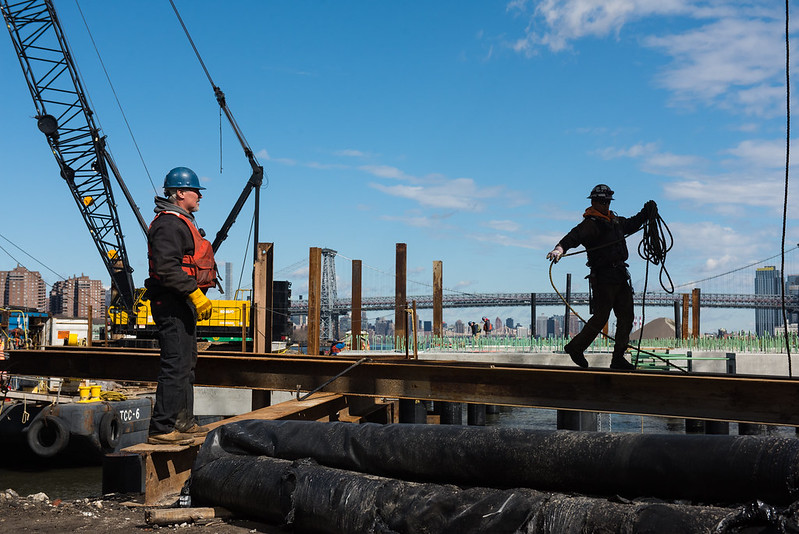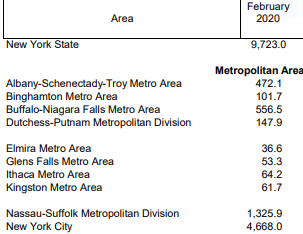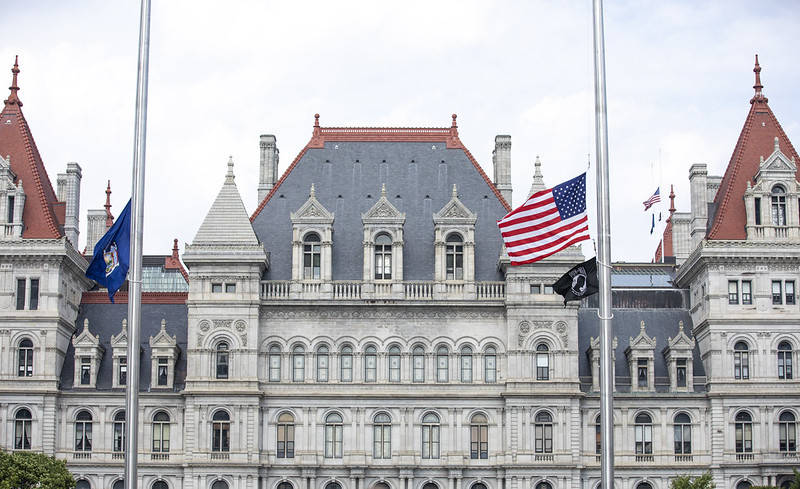My Dream was to Become a Cop; Then Things Changed

Police recruits (photo: mayor's office)
Almost a month ago I graduated from John Jay College of Criminal Justice, the premier college in the country for leaders in law enforcement. Today, I am taking the first steps to find a job in social work, convinced, like many people my age, that keeping my community safe has to start with compassion and respect, not violence.
I started like many other students at the college, ready to become a cop. My cousin is a state trooper, and my grandfather served in the military in the Dominican Republic. I love my family's history, and I wanted to protect the neighborhood in the Bronx that we emigrated to in 2006 when I was a kid. I was going to be an officer that came from the same community I was going to serve. The type of officer who understood the hard life of Latino people in the Bronx, and was willing to put his life on the line. My parents were scared for me but supported my passion.
One of the first professors I had in the department of police science at the college was a retired NYPD captain, a role model for who I wanted to become. He would always tell us the struggles he faced trying to change the department's culture to emphasize community policing and end racism and brutality. He told everyone in his command that if they didn't like how he went about business, then he would get officers who would. He was an inspiration and cared about the community, but it never seemed like he won those arguments or changed the minds of many officers. He seemed to be an outlier in policing that was hard to find.
The more classes I took in policing and correction, the more I realized how bleak it is to try to reform policing from the inside. I wanted to be in a profession that did not make me question my values. I wanted to be there for the people without continually questioning my actions or the actions of those around me. I had a change of heart and decided to pursue a career in social work because it focuses so directly on helping individuals, families, and communities.
Growing up with immigrant parents and as a first-generation immigrant I learned the importance of support services. When I interned at the Northern Manhattan Coalition for Immigrant Rights, one of my duties was to conduct mock interviews with people preparing to take their citizenship exam. This is where I realized the impact I could have. Seeing the joy of those who passed their interview and became a United States citizen inspired me as much as taking a class from a retired police captain. Their reactions give me the motivation to keep moving forward to impact as many lives as possible in a positive direction.
My decision to pursue a career in social work was not connected to the protests to defund the police -- I made my choice long before this year and the events of the past weeks. I believe that the police need to be held accountable. There are many avenues that need to be explored, among them possibilities around defunding and adjusting the police budget in New York City.
Precious funding can be better allocated towards social services and the needs of underrepresented communities. As the conversation has picked up steam, I know firsthand that if our city supported groups like the ones I interned with or the hundreds of other under-funded social service organizations across the city, my community would be healthier, better educated, and happier.
When I was struggling over my career change, I remember a professor reassuring me that there are many paths where I could make an impact. "You could help so many people without having to be a police officer," she told me. It is with that mindset that I keep moving forward to the next chapter of my life. I am eager to do just that and support every one of my fellow graduates from John Jay and other institutions who are planning to do the same to help our city make much-needed progress.
***
Jerel Pena Duran is part of the John Jay College of Criminal Justice class of 2020.
***
Have an op-ed idea or submission for Gotham Gazette? Email This email address is being protected from spambots. You need JavaScript enabled to view it.
‘Real’ Unemployment in New York City is as High as 25%, with 1 Million Out of Labor Force Due to Pandemic

Construction workers (photo: Edwin J. Torres/Mayor's Office)
Labor statistics can be very confusing, especially for the general public.
The Bureau of Labor Statistics (BLS) just released its June 2020 report, and while it does show an uptick in employment across the nation, economic pain remains widespread. The numbers for New York City and New York State, while they lag behind the national report, show more severe difficulties. A New York Times article described the stunning local catastrophe.
Unemployment Stats - Who's In, Who's Out
Writing about the Bureau of Labor Statistics May 2020 employment report, I discussed the fact that more than 6 million persons had dropped out of the labor force between February and May 2020 and were no longer counted in the unemployment rate released that month.
Believe it or not, these labor force dropouts are not counted as unemployed.
It is the "civilian noninstitutional population 16 and over" who are working or looking for work who are counted as the labor force, and the percentage of those working or looking for work are calculated as the "labor force participation rate" out of the total civilian noninstitutional population over 16.
But those who have just dropped out of the labor force are human beings, not statistics, and are part of the overall human damage of the current covid recession and labor market concerns in general.
The U.S. June Employment Report
In the just released BLS June 2020 report the updated number for those who have dropped out of the labor force since February is 4.6 million. About 1.7 million persons re-entered the labor force in June, with presumably most regaining employment. Here is the table showing the data from the BLS June employment report for the size of the labor force and the participation rate:

Overall, the BLS reported for June that payroll employment rose by 4.8 million from May and the unemployment rate dropped to 11.1% from 13.3%. It showed a partial resumption of economic activity since the pandemic-induced major job shutdown in March and April that cut 22.2 million American jobs; 2.7 million jobs had been regained in May. The table shows the labor force was 164.5 million in February 2020 and 159.9 million in June 2020.
But now, Coronavirus Surges in Parts of the U.S.
While the gain was good news, the data were collected in mid-June and since then the explosion in coronavirus cases in the South and West has led to curtailment of economic activity in some states, including the three largest states: California, Texas, and Florida, and seems likely to limit near-term recovery of the economy. And, of course, nearly 15 million of the 22 million Americans who have lost their jobs since February are still unemployed.
New York City and State
Comparable data on labor force dropouts are available for New York City and State along with the general employment reports. The overall unemployment rates for New York City and New York State for May (state-by-state reports lag behind the national report) taken from the New York State Labor Department (whose data come from BLS) were as follows:

NYS and NYC Lost Jobs
New York State lost nearly 1.7 million jobs, and New York City about 890,000 jobs, respectively, between February and May 2020, according to data from State Labor Department releases that use the BLS reports (these data are not seasonally adjusted). These are payroll jobs, which include out-of-state residents, and represent different numbers than household employment data, which also include the self-employed. Here are the New York payroll reports:


Unemployment rates are calculated from the Household data, which also show the size of the labor force on a monthly basis and the dropouts can be calculated from this data -- they move over to the category of not in the labor force and are not included in the unemployment rates.
Adding Labor "Dropouts" to New York City Stats Reveals a Real Unemployment Rate That Could be as High as 25%
Bureau of Labor Statistics data show that 462,000 persons dropped out of the labor force in New York State between February and May 2020, from 9.551 million to 9.089 million. In New York City, 381,000 persons dropped out of the labor force during this period, with the force dropping from 4.051 million to 3.670 million persons. Here are the data, taken from BLS state employment situation reports:

![]()

![]()
If the size of the labor force in New York City was still the same number of people as in February, 4.05 million, but the number of persons who have dropped out since that time (381,000) were added to the number unemployed in May, 671,000, the number unemployed would be 1.05 million out of what would be 4.05 million people in the labor force. That would bring the unemployment rate to just over 25% in New York City.
No Matter How You Calculate It, the Pandemic's Effect on the City's Employment is Staggering
Of course the real number wouldn't be that high because some of the dropouts might have decided to retire, or no longer be seeking work for some noneconomic reason like taking care of family. But the point is that the number of New York City residents who are out of the labor force since February, related to the pandemic, is immense.
In May 2020 the number of persons who dropped out of the labor force from February at the national level was 6.3 million; in New York City, the number was 381,000, or about 6% of the total number of labor force dropouts across the country, more than double the city's share of the nation's population, which is 2.5%.
Don't Expect a Quick Recovery in the City
The next state-by-state employment situation from the Bureau of Labor Statistics will be released on July 17. At the national level, about one-third of the persons who had dropped out of the labor force through May returned to the labor force by mid-June. New York State permitted all the regions of the state except New York City to expand their economic activity to a Phase III level pursuant to state guidelines, while New York City was allowed to reach Phase II level. The BLS is likely to have recorded some of this increase in economic activity in New York and our hard-hit state may show some meaningful improvement. But it's within the context of the severe damage to the economy, and predictions of economic recovery are far in the future.
***
Jim Brennan was a member of the New York State Assembly for 32 years, where he chaired four committees. On Twitter @JimBrennanNY.
***
Have an op-ed idea or submission for Gotham Gazette? Email This email address is being protected from spambots. You need JavaScript enabled to view it.
We Were Proud to Vote for Police Reforms, Now It’s Time for Prison Reform

The State Capitol Building (photo: Governor's Office)
The murders of George Floyd, Breonna Taylor, and other Black people at the hands of police sparked righteous calls for change across New York State and led to meaningful action in Albany. We were proud to vote for police reforms that promote more transparency, accountability, and justice for those we represent. These were important steps, but they fall short of addressing the harm that happens to our constituents behind bars.
For years, we’ve spoken with mothers, children, and other people in our communities whose loved ones have suffered while incarcerated in our state prisons. This harm is often fatal and happens out of the view of cellphone cameras. Unsurprisingly, people of color disproportionately experience this harm.
Black and Latino people make up 34% of all New York State residents but represent 72% of the state’s incarcerated population. Amidst COVID-19, 80% of people who died in the custody of our state prisons were people of color -- 60% were Black people. Many of these people were older and posed no risk to public safety.
Black people and other people of color are disproportionately serving longer prison sentences and given fewer opportunities for release than their white counterparts. In New York State in particular, years of investigations have exposed that the State Parole Board disproportionately denies parole release to Black people, even when compared to their white counterparts with similar convictions and institutional records.
There are also roughly 1,000 New Yorkers serving prison sentences that don’t even allow a chance at release or public safety assessment. These cruel and unusual punishments amount to New York’s new form of capital punishment: death by incarceration. Curbing state violence on the streets does not address the full spectrum of harm if we continue systematically sentencing mostly Black and Latino people to die in prison without any meaningful second chance, exemplified by the tragic cases of Valerie Gaiter, Benjamin Smalls, and so many others.
People can be held accountable without being sentenced to die in prison. Victims and survivors can find healing without the person or people who harmed them facing a lifetime of punishment and torture. New York can promote safety and decarceration at the same time. We are ready to address these forms of state violence by passing two bills this state legislative session: our Elder Parole Act and the Fair and Timely Parole Act.
Elder Parole would allow the Parole Board to individually assess incarcerated people for a chance at release once they’ve served 15 more or years and are aged 55 or older. The bill would effectively end prison death sentences in New York State and help us move beyond our shameful distinction of having one of the highest prison populations of people serving life sentences in the country.
Fair and Timely Parole is just as important. It would change the Parole Board’s culture of punishment and vengeful practice of blanket parole denials by ensuring that parole release decisions are based on who people are today, instead of just on the nature of their crime. If at least part of the purported purpose of incarceration is rehabilitation, then the Parole Board’s decisions must be guided by people’s change over time.
These two bills, which align with decades of criminal justice research and public safety data, would allow us to reinvest resources, and would bring families back together. In this particular moment, they would also bring us steps forward in our lifelong battle to end structural racism and state violence.
***
Carmen De La Rosa is a New York State Assembly Member representing parts of Manhattan and the lead sponsor of Elder Parole (A.9040). Gustavo Rivera is a New York State Senator representing parts of the Bronx and is the lead sponsor of the Fair and Timely Parole Act (S.497A). On Twitter @CnDelarosa & @NYSenatorRivera.
***
Have an op-ed idea or submission for Gotham Gazette? Email This email address is being protected from spambots. You need JavaScript enabled to view it.




